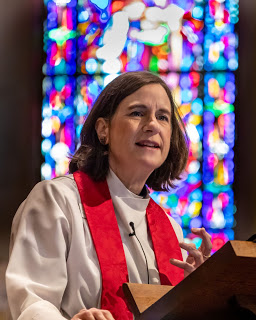
March 21, 2021, The Fifth Sunday in Lent
Penelope Bridges
Lifted Up
In the name of our loving, life-giving, and liberating God.
What is the Bible saying to you today? What do these Scripture readings say to you as you read them in the context of the world we are living in, in the context of the pandemic, the economic and political divisions, the confrontation with systemic racism, the pain and suffering that we see around us? Participation in the Sacred Ground curriculum has been opening my eyes to social dynamics I had been unable or unwilling to acknowledge, and it acts now as a filter between me and these ancient texts of truth and power. Theologian James Cone puts it like this: “The Bible is our primary source of information about the Jesus we encounter in our social existence.”[i]
Cone says that in the Black faith traditions, “The Bible is transformed from just a report of what the disciples believed about Jesus to black people’s personal story of God’s will to liberate the oppressed in their contemporary context”[ii]. As my colleague Orlando Espin suggests, we can think of Jesus as a landless peasant belonging to an oppressed people, accorded a social status with which millions of our less privileged neighbors can identify much better than we can. For people of color, the practice of Christian faith is a dialogue between the crucified Jesus and their own suffering of oppression and injustice.
In light of our current context, when I read (RED) today’s portion of Psalm 119, the first verse held special resonance in light of the horrific shootings this week of eight massage parlor employees in Georgia. That first line speaks to a particular brokenness as it asks, “How shall a young man cleanse his way?” or, in other translations, “How can young people keep their way pure?”. That word, “pure” is a trigger for me today. If you read [RED] about the murders in Atlanta, you may have seen that the alleged perpetrator is a 21-year-old white man, the son of a youth pastor in a Southern Baptist congregation. He told police that he carried out these murders of 8 people, 6 of them Asian women, because he thought that eliminating them would cure him of inappropriate desires.
In parts of the evangelical tradition, there is a strong purity culture where young people are taught that any sexual desire is evil. It’s particularly brutal on LGBTQ youth, but it does terrible damage to the spiritual and mental health of many kids, as they wrestle with the strong emotions of adolescence. What sort of twisted logic, what sort of teaching, masquerading as Christian formation, leads someone to believe that it’s OK to kill people – specifically women of another skin color – in order to gain control over their own biological urges? This is an evil that must be brought to light as part of the plague of white supremacy in this country, a part that is intimately connected to an expression of Christianity. So much for the purity culture.
Looking at the Gospel passage today, like Jeff last week, I found myself captivated by the evangelist John’s language about Jesus being lifted up from the earth so that all might gaze upon him. It’s interesting that this language appears in consecutive Sunday readings, in chapter 3 and in chapter 12 of John’s Gospel. Hmmm, maybe we are meant to pay close attention to that image.
The second half of John’s Gospel is known as the Book of Glory, following the first half, the Book of Signs. As John begins the Book of Glory, Jesus confronts his own suffering, which he characterizes as his glorification. He is troubled, as any human being would be, but he still walks towards it. By embracing his suffering and death he enters fully into solidarity with the suffering of all the children of God. This is the essence of his purpose, God’s purpose in becoming incarnate, to stand with the oppressed and the powerless, to submit to the same pain and humiliation that much of humanity suffers. This is not just about the chosen people of the Hebrew Scriptures; Jesus will be lifted up for ALL people. All are beloved and precious; all are broken and in need of redemption. And the Crucifixion lifts up the suffering of Jesus to be fully visible, impossible to disregard, an indictment on injustice and violent oppression in all eras and nations.
Let me tell you a story about a sweet-faced boy, born and raised in Chicago, full of hope and promise. When this boy was six he contracted polio, which left him with a speech impediment. He was a happy child, and fiercely protective of his mother. He was curious about his family’s roots in Mississippi, and he decided to go there for a summer vacation, despite his mother’s misgivings about his safety there. On an August Sunday he and his cousin skipped church and went to the local store to buy candy. What happened next is disputed, but he was accused of flirting with the young white woman behind the counter. Her husband and brother-in-law subsequently kidnapped, tortured, and murdered the boy and threw his body in the river, where it was found several days later.
The Cross and the Lynching Tree[iii] is a magisterial study by James Cone on the theology and Christology of the African American faith tradition. Reflecting theologically on the lynching of Emmett Till in 1955 at the hands of white supremacists, Cone describes how Emmett’s mother, Mamie Till Bradley, publicly gazed on the mutilated corpse of her son, recalling the Pieta image of the Blessed Virgin Mary gazing on the body of Jesus. Jennine Hill Fletcher of Fordham University[iv] paraphrases Cone describing how Mrs Bradley “insisted on gazing lovingly on her son’s corpse to take in the specificity and intimacy of the horror as real and irreversible, and simultaneously to insist on her son as the image of God.”[v] The open casket that she insisted on at Emmett’s funeral parallels the image of Christ on the cross that we gaze upon in adoration.
Cone makes an explicit connection to the Gospel: “For Mrs Bradley, the voice that she heard was the voice of the resurrected Jesus. It spoke of hope that, although white racists could take her son’s life, they could not deprive his life and death of an ultimate meaning”. [vi] Just as Jesus’s crucifixion made visible the systemic sin of humanity, so Emmett’s death made visible the systemic racism of white America. Just as Jesus’s death became the means to defeat death, so Emmett’s death and the courage of his mother provided a catalyst for the civil rights movement. That struggle has not yet been won, to our shame. There have been far too many Emmetts and Mamies in the 66 years since that tragedy. And the church has too often been complicit, using and misusing Scripture to justify white supremacy and the dehumanization of people of color.
But, just as Jesus, by his embrace of horrendous violence, revealed the redemptive grace of God and made it available to all humanity, so Mamie Till Bradley revealed that grace by lifting up her broken child from the earth in faith and giving meaning to the suffering of her 14-year-old son. And Jesus continues to be lifted up before us on the Cross, the image becoming ever clearer as we approach Holy Week.
Jeremiah offers a hopeful vision of a new covenant between God and humankind, an unbreakable covenant. “This is the covenant that I make, says the Lord, I will put my law within them, and I will write it on their hearts; and I will be their God, and they shall be my people.” What is this law that should be written on our hearts? Surely it is the dual commandment, to love God and to love neighbor; a law of peace, not violence; of compassion, not cruelty; the law that Jesus taught and personified, the law of love.
Jesus’s submission to the Cross in self-giving love stands in resistance to the way of violence that our world still espouses. Martin Luther King pointed out what should be obvious, that we cannot defeat violence with violence, saying, “We adopt the means of nonviolence because our end is a community at peace with itself.”[vii] And more pointedly, “Nonviolence is absolute commitment to the way of love. Love is not emotional bash; it is not empty sentimentalism. It is the active outpouring of one’s whole being into the being of another.”[viii] Active outpouring: this is what Jesus did on the Cross; the “other” for him was all of humanity.
As the body of Christ here and now, we too must be active in our commitment to the way of love, bringing to light the wounds of our history, seeking truth and reconciliation, and putting our hope in the God who will write the law of love on our hearts and lead us forward to the true peace and justice of the resurrection.
[i] James Cone God of the Oppressed (Maryknoll, NY: Orbis, 1997) p.102
[ii] Cone, God, p. 103
[iii] James Cone The Cross and the Lynching Tree (Maryknoll, NY: Orbis, 2011)
[iv] Jennine Hill Fletcher, “The Christology of the Lynching Tree”, in Black Theology Papers, 4:1 (2018)
[v] Cone, Cross, p. 67
[vi] Cone, Cross, p.69
[vii] Dr. Martin Luther King, Jr., Nobel Lecture, 1964
[viii] Dr Martin Luther King Jr., 1957

